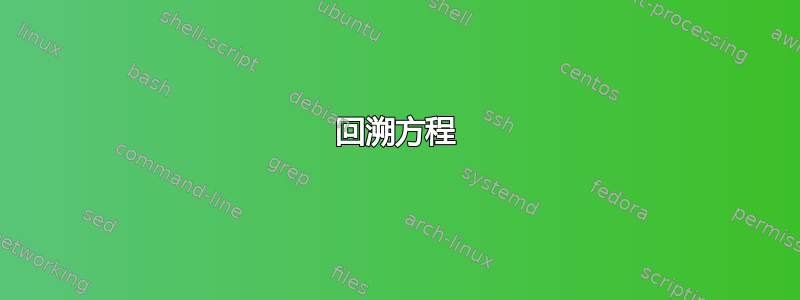
我一直在尝试创建可复制回溯框的代码。如果不使用两个不同的 tikz 图片,我无法拆分框。我希望箭头从框中间穿过,并且我希望有足够的空间让学生将答案放入框中。此外,文本在我的图片中是倒置的,我无法使用 $ 符号输入方程式,因为它是文本。
我的 MWE 如下
\documentclass[10pt]{article}
\usepackage{tikz}
\usetikzlibrary{arrows}
\usetikzlibrary{shapes}
\tikzstyle{data}=[rectangle split,rectangle split parts=2,draw,text centered]
\usetikzlibrary{decorations.text}
\begin{document}
\begin{tikzpicture}
\node (One) at (-2,0) [shape=rectangle,draw, ] {$p$};
\node (Two) at (2,0) [shape=rectangle,draw] {$2p$};
\node (Three) at (6,0) [shape=rectangle,draw] {$2p - 5$};
\def\myshift#1{\raisebox{1ex}}
\draw [->,thick, red, postaction={decorate,decoration={text along path,text align=center,text={|\sffamily\myshift| x 2}}}] (One) to [bend left=45] (Two);
\def\myshift#1{\raisebox{1ex}}
\draw [->,thick, red, postaction={decorate,decoration={text along path,text align=center,text={|\sffamily\myshift| -5 }}}] (Two) to [bend left=45] (Three);
\def\myshift#1{\raisebox{1ex}}
\draw [->,thick, red, postaction={decorate,decoration={text along path,text align=center,text={|\sffamily\myshift| 5 }}}] (Three) to [bend left=45] (Two);
\def\myshift#1{\raisebox{1ex}}
\draw [->,thick, red, postaction={decorate,decoration={text along path,text align=center,text={|\sffamily\myshift| div 5 }}}] (Two) to [bend left=45] (One);
\end{tikzpicture}
\end{document}
答案1
这是实现此目的的一种方法。一些注释:
分割矩形
\nodepart{two}可以省略- 然而,为了使用
\strut元素,我把它们放在 \strut是一个宽度为 0 的结构框- 在
text环境中,它只是保持高度恒定,因为...... - ... 高度
node根据文本内容而变化
連接
- 这里不需要装饰,让事情变得更容易
- 使用
to [bend left]只是弯曲线条的一种方式 - 为了稍微移动箭头的锚点,我使用了极坐标,参见
% comments - 放置标签的方法有很多种;这里我使用了
node {}插入路径 - 它们的格式
txt,并将txb标签移离箭头
\documentclass[10pt,border=3mm,tikz]{standalone}% during development
\usepackage{tikz}
\usetikzlibrary{shapes.multipart,arrows.meta}
\begin{document}
\begin{tikzpicture}[
box/.style={rectangle split, rectangle split parts=2,
draw, % show the rectangles
minimum width=20mm% make large for a uniform width
},
arr/.style={->, red, >={Stealth}},
txt/.style={black, yshift=+2.5mm},
txb/.style={black, yshift=-2.5mm},
]
% ~~~ text boxes ~~~~~~
% \strut is a LaTeX text element; effect: makes heights equal
\node[box] (A) at (0,0) {\strut $p$ \nodepart{two}\strut};
\node[box] (B) at (3,0) {\strut $2 \times p$ \nodepart{two}\strut};
\node[box] (C) at (6,0) {\strut $2 \times p - 5$ \nodepart{two}\strut};
% ~~~ connectors ~~~~~~~
% anchors: (A.north) == (A.90); (A.south) == (A.270)
\draw [arr] (A.80) to [bend left] node[txt] {$\times 2$} (B.100);
\draw [arr] (B.80) to [bend left] node[txt] {$- 5$} (C.100);
\draw [arr] (C.260) to [bend left] node[txb] {$+ 5$} (B.280);
\draw [arr] (B.260) to [bend left] node[txb] {$\div 2$} (A.280);
\end{tikzpicture}
\end{document}
inner ysep=5mm向样式中添加box...
box/.style={rectangle split, rectangle split parts=2,
draw, % show the rectangles
minimum width=20mm,% make large for a uniform width
inner ysep=5mm
},
结果是
答案2
如果您多次需要此功能,我建议使用chains可以自动放置节点并可即时连接它们的库。
代码
\documentclass[tikz]{standalone}
\usetikzlibrary{arrows.meta, chains, shapes.multipart}
\makeatletter
\tikzset{
save tikztonodes/.style={every to/.append style/.expanded={
edge node={\pgfutil@unexpanded\expandafter{\tikz@tonodes}}}}}
\makeatother
\tikzset{
/utils/temp/.style n args={3}{
backtracking equations/step #1/.style={edge label={$#2##1$}},
backtracking equations/step' #1/.style={edge label={$#3##1$}}},
/utils/temp/.list={++-, --+, *\times\div, :\div\times},
every backtracking equations diagram/.style={
start chain=going right, node distance=1em},
backtracking equations/.cd,
data/.style={
rectangle split, draw, minimum width=4.6em,
rectangle split parts=2, rectangle split horizontal=false},
every conn/.style={auto=left, nodes={text=blue}, red, >=Latex, bend angle=30},
arr >/.style 2 args={
backtracking equations/every conn, ->, backtracking equations/step #1={#2},
to path={[save tikztonodes] ([xshift=+0.1em]\tikztostart.north)
to[bend left] ([xshift=+-.1em]\tikztotarget.north)}},
arr </.style 2 args={
backtracking equations/every conn, <-, backtracking equations/step' #1={#2}, ',
to path={[save tikztonodes] ([xshift=+0.1em]\tikztostart.south)
to[bend right] ([xshift=+-.1em]\tikztotarget.south)}}}
\newcommand*\tikzbackeq[2][]{%
\tikz[every backtracking equations diagram,#1]
\foreach \content/\step in {#2}
\node[backtracking equations/data, on chain,
join=by {backtracking equations/arr >/.expand once=\step},
join=by {backtracking equations/arr </.expand once=\step}]
{\strut$\content$ \nodepart{two} \strut};}
\begin{document}
\tikzbackeq{p, 2p/*2, 2p-5/-5}
\tikzbackeq{p, p+3/+3, \frac{p+3}{2}/:2, \pi\frac{p+3}{2}/*\pi}
\end{document}
输出
答案3
使用{NiceTabular}和nicematrixTikz 绘制箭头。
\documentclass{article}
\usepackage{nicematrix,tikz}
\usetikzlibrary{arrows.meta}
\begin{document}
\newcolumntype{O}{w{c}{1cm}}
\[\setlength{\arraycolsep}{2pt}
\begin{NiceArray}{OcOcO}
\Block[hvlines]{2-1}{}p && \Block[hvlines]{2-1}{}2p && \Block[hvlines]{2-1}{} 2p-5 \\
\\
\CodeAfter
\begin{tikzpicture} [->, draw=red, >=Latex, bend left]
\draw (1-|1.5) to node [auto] { $\times 2$ } (1-|3.5) ;
\draw (1-|3.5) to node [auto] { $-5$ } (1-|5.5) ;
\draw (3-|5.5) to node [auto] { $+5$ } (3-|3.5) ;
\draw (3-|3.5) to node [auto] { $\div 2$ } (3-|1.5) ;
\end{tikzpicture}
\end{NiceArray}\]
\end{document}








